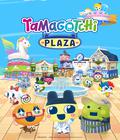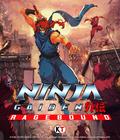The Switch is a good platform for indie games, and Nintendo's focus to get an interesting array of them has been successful thus far. The company also knows how to blindside us with unexpected announcements, one of which was Aegis Defenders, a game that was successfully funded on Kickstarter over three and a half years ago, just short of reaching the next stretch goal: a Wii U version. The game was recently picked up to be published by Humble Bundle, and apparently, a Switch version was created anyhow. It's a no-brainer to put a 2-D platformer/tower defense game with local co-op on the system. Does the mixture of gameplay mechanics hold up?
Out of all of the possible gameplay mash-ups, tower defense and 2-D platformer would've been my last guess, but at the same time, it makes a lot of sense when you look at the gameplay trailers. Due to the nature of Kickstarter, there is a lot of information online about the creation process of Aegis Defenders. It's no masterpiece, but there are good and entertaining elements present.
Aegis Defenders breaks quite a few of the genre conventions by having a fully fleshed-out story. At the start of the game, we control two characters — Bart, an old engineer, and his granddaughter, Clu, the ruin hunter — on their quest to find ancient technologies and scrap to sell for their livelihood. When they move to a new region, they stumble upon an ancient weapon, the Aegis, that could alter the world. This world used to be ruled by the deathless, gods who ruled over mankind until they were destroyed by a similar weapon, the Clarent, during a human rebellion. The group and its leader are still in control of the area and cannot be allowed to control the Aegis, the fate of which now lies in the hands of our protagonists, an assassin, a monk and a robot companion.
Apart from rich and detailed pixel art environments, the story is told in short text-based cut scenes between the characters, most of which are well written and can be funny. Between levels, there are cut scenes that depict past events leading up to this dystopian future. Considering the genre, it's a solid and well-told story that goes with the gorgeous art style of the world, and it's believable and engaging throughout.
The biggest gamble Aegis Defenders takes is not its story, but its gameplay mix. At the core, it looks and plays like a 2-D platformer/Metroidvania-inspired game. We jump and shoot through sometimes challenging self-contained stages, solve puzzles, use switches, and face tough enemies until we reach our objective. Once we reach the end of a stage, the game switches into tower defense mode, where we have to protect ourselves and other targets against waves of monsters. In order for this to work, the game and level design have to be on point in both the platforming and the tower defense.
Let's take a look at the characters first, as their abilities drive the gameplay. Our starting duo sets the groundwork, with Bart fighting up-close with hammers and shovels and Clu shooting long-range weapons and bows. During tower defense, the rules are reversed, with Bart building turrets and repairing things while Clu lays bombs and spikes on the floor. The other two characters, who join up later in the story, add more abilities and turrets. The assassin wields a shuriken that acts like a boomerang that passes through walls, and she also has sticky bombs. Her turrets slow down enemies or heighten chances for critical hits. The monk can throw fireballs or circle orbs, and his turrets emit fire to either damage enemies or add fire damage to other projectiles.
It's a simple mix-and-match concept that makes the gameplay more approachable. The variety of turrets is expanded by mixing the character abilities to create different turrets or machines that produce resources. Speaking of resources, they have to be collected for each individual character and are embedded in the level design.
With a few exceptions, almost all stages start with a platforming segment. They're initially rather easy, but the difficulty ramps up as we need to cleverly use our different characters and abilities. All characters are color-coded, so they deal more damage to enemies of the same color, and for puzzle purposes, they can enter areas of their color. Later on, characters get secondary weapons that are deal damage to all foes. Most of the puzzles involve reaching and activating certain switches, but they often introduce new environmental threats and mechanics to keep things interesting. For example, bubbles can carry us through a level based on air vents, beams or wind flow.
The platforming section works well enough in small bursts, but it can be rather frustrating. There are instances where the collision detection isn't great, so we'd fall off a cliff instead of standing on solid ground. On some occasions, the background tricked us into thinking we should be able to reach certain areas but we ran into an invisible wall instead. Yet another headache is how the game handles damage. After falling to your death, you return to the last spot where the game thought you were on solid ground, but those points are sometimes further back than you were or set you down in front of enemies. It's not overly common, but those situations turn the otherwise charming gameplay into moments of frustration — and that frustration carries over to the tower defense segments.
While Aegis Defenders is pretty decent in the platforming sections, the game shines in the tower defense aspects by marrying the platforming level design with wave-based tower defense. There's an object to protect in the middle of the level, and enemies pour in from different sides to reach it. If we let an enemy through or lose all our health, the base loses a heart, and when the base runs out of hearts, we lose. Prior to each wave, we have time to prepare while the game shows us where enemies will come from and what color they'll primarily have, so we can plan accordingly.
During this phase, we may gather available resources from the map and build as many turrets as possible in anticipation of the oncoming enemy. It becomes more complicated as levels get more complex in structure and environmental hazards. The portals and air vents make an entrance, as well as color-coded areas that only a specific character can enter. Similar to the platforming levels, it starts out simple enough but ramps up halfway through, when levels become more dynamic. There are a handful of stages that require the defense of a moving target.
If it weren't for these frequent changes, Aegis Defenders would only be half as entertaining, as it forced us to constantly rethink our strategies. However, that also meant that stages got increasingly confusing, so it was often difficult to recognize which routes enemies could potentially take, and that sometimes resulted in costly mistakes. The tower defense endeavor can occasionally become confusing and frustrating when confronted with the platforming issues. However, unlike the platforming sections, the tower defense portions of the game are always fun and inspire a "just one more" attitude that pulls you through the game.
However, there are more elements that I couldn't come to terms with. The controls are pretty loaded, but they work and can be reassigned if necessary. They were never perfectly spot-on for me, and I had a few mishaps when building turrets. Some levels also have interactable objects that are accessed with the same standard button for building, which can cause time-consuming misinterpretation of your inputs, like manning a turret instead of building something. When you're playing the game cooperatively, that may not be as much of an issue, but when playing alone, the game doesn't feel as well designed as it should be.
When playing solo, we need to switch characters frequently, get resources, build, and get into position; the AI does none of that on its own. We can either have it walk with us and take no action, even when it's attacked, or we can permanently position them at their current whereabouts so they can attack enemies or, in Bart's case, repair turrets. They don't even turn around or walk an additional step, so taking responsibility for all of that on your own is stress-inducing and can certainly kill the fun factor. Please play with a friend if you can because the game is more fun when there's an additional mind working to defend your base. This is where the game shines.
Aegis Defenders rates us at the end of each level based on how many collectibles we found in a stage and how many hearts we lost defending our base. We receive ruin hunter points and money to upgrade our equipment, health and turrets. There are also three cameo levels, one with Shovel Knight, where we can earn extra cash and skins for our two main characters. We also have the option to return to the previous level to increase our ranking, but we're always required to play the entire level. The game has no option for us to skip the platforming to go straight to the tower defense part for a quick fix, which is unfortunate and sometimes kept me from returning when I wanted to.
Visually, the game is simply beautiful. The character art and environments have been crafted with love, and it shows. The same goes for the music, which does an excellent job of luring us in for the roughly 15-hours single-player campaign (a co-op playthrough may take less time). Performance-wise, the game has a few slowdowns when the action gets too intense, and there have been a few minor glitches, but nothing game-breaking, so the Switch version is a pretty solid endeavor in both docked and undocked modes.
Aegis Defenders is a beautiful game with an intriguing concept and fun gameplay, but it can be rough around the edges, the platforming isn't necessarily something to write home about. Playing alone can feel quite stressful and unfair. Aegis Defenders is best when it pins you in an arena with a buddy at your side and waves of enemies to tackle. In those instances, it provides more than enough gameplay and fun to justify its $20 price tag.
Score: 7.3/10
More articles about Aegis Defenders











 Aegis Defenders is an 16-bit adventure that blends Metroidvania-style combat with tower defense strategy.
Aegis Defenders is an 16-bit adventure that blends Metroidvania-style combat with tower defense strategy.




















